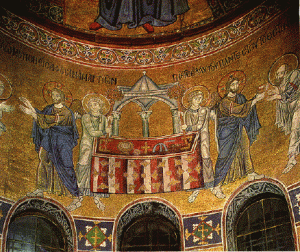Byzantium on the Volga
Jack asks how close early Russian culture was to Byzantine culture.
The Rus had contact with Constantinople at least as early as the 830’s, but the close ties began with the Rus adoption of Christianity in 989. As always with Byzantine policy, Christianity was the main vehicle for the transmission of culture. The first cathedrals in Russia were built by imported Byzantine architects and they were decorated by imperial artisans. St. Sophia of Kiev, the premier Rus architectural achievement of the 11th century, was modeled on the Hagia Sophia and its metropolitan was subordinated to the Patriarch of Constantinople. By the 1040’s a Byzantine traveler to Kiev would have found it at least visually familiar.
But Russian culture was never a simple copy of Byzantium. It took centuries for Christianity to spread across the vast Rus lands and only a select part of Byzantium was absorbed. For instance, although the Bible was rendered into Old Church Slavonic there is no evidence that any of the Greek treatises on philosophy, mathematics, or science were translated. In other words, the Rus were only interested in some aspects of imperial culture- mostly the magnificent pageantry. The divine liturgy was imported along with the dress and trappings of the court, but the literature was passed up. By the end of the 11th century Constantinople’s pull was beginning to wane and then in 1236 with the invasion of the Golden Horde Russia was wrenched firmly into the Mongolian orbit.

The analysis of cultural influence of Second Rome over the Rus cannot be really complete without considering the role that the First Bulgarian Empire played as a cultural mediator.
The development of the Cyrillic alphabet as well as the first translations of the most important religious texts in to Old Bulgarian (Old Church Slavonic) have already occurred in Bulgaria in the end of the 9th and beginning of the 10 centuries.
This already existent Slavic Orthodox culture has made it much easier for the Rus to be successfully integrated into Byzantine Eastern Orthodoxy.
Clerics from the Second Bulgarian Kingdom, like Gregory Tsamblak in the 15th century have also played a role in the cultural exchange between Byzantium and Russia.
On this note, I would really love to see a post in this great blog about the first and second Bulgarian kingdoms and their relationship to and influences on the history of the Byzantine Empire. A relationship that has spanned 7 centuries.
I couldn’t agree more. Sir Steven Runciman started to explore the relationship between Bulgaria and the Empire in his biography of Romanus Lecapenus- I sincerely wish he could have followed it up with more. I think Bulgaria provided the initial template for Byzantine contact with its Slavic neighbors- detaching the liturgy from Greek (unlike the Roman policy of enforcing a Latin mass) and encouraging a limited autonomy both religiously and culturally. The result was a Byzantine ‘commonwealth’ which outlasted the empire and paradoxically increased the ties to Byzantine culture. Compare that to the relative speed in which Roman institutions disappeared from the ‘barbarian’ west after 476.